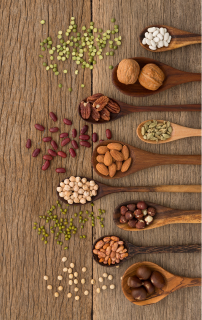Understanding the Importance of Fiber
You probably already know that fiber is essential for good health, but do you know exactly why and if you are getting enough? According to the National Academy of Medicine, daily fiber intake should be 25 grams for women age 50 or younger and 21 grams for women age 51 or older. While men age 50 or younger require about 38 grams and men age 51 or older need around 30 grams of daily fiber. However, many people fall short of these recommendations. According to Harvard Health, American adults eat on average only 10 to 15 grams of fiber every day.
Why Fiber is Vital

Dietary fiber is primarily known for its ability to prevent or relieve constipation. However, its health benefits extend far beyond that:
- Normalizes bowel movements: Fiber adds bulk to your stool, which helps regulate bowel movements and prevent constipation.
- Maintains bowel health: A high-fiber diet can reduce the risk of developing hemorrhoids and small pouches in your colon (diverticular disease).
- Lowers cholesterol levels: Soluble fiber found in oats, beans, and flaxseed can help lower total blood cholesterol levels by reducing low-density lipoprotein (LDL) or “bad” cholesterol.
- Controls blood sugar levels: Fiber, particularly soluble fiber, can slow the absorption of sugar and help improve blood sugar levels.
- Aids in achieving and maintaining a healthy weight: High-fiber foods are more filling than low-fiber foods, helping you stay satisfied longer and reducing your overall calorie intake.
Types of Fiber: Soluble vs. Insoluble
Fiber falls into two categories: soluble and insoluble. Each type works differently in your body and offers distinct health benefits.
- Soluble Fiber: Dissolves in water to form a gel-like material. It can help lower cholesterol and glucose levels. Sources include oats, peas, beans, apples, citrus fruits, carrots, barley, and psyllium.
- Insoluble Fiber: Does not dissolve in water. It promotes the movement of material through your digestive system and increases stool bulk. Sources include whole-wheatflour, wheat bran, nuts, beans, cauliflower, green beans, potatoes, and brown rice.
To reap the full range of health benefits, try to incorporate both types of fiber into your diet.
Adding Fiber to Your Daily Diet
Increasing your fiber intake doesn’t have to be difficult. Here are some practical tips to help you boost your fiber consumption:
Fruits
Consume a variety of fiber-rich fruits such as:
- Oranges – 3 grams
- Apples, with skin – 4.5 grams
- Mangoes – 5 grams
- Strawberries 1 cup – 3 grams
- Raspberries 1 cup – 8 grams
- Blackberries 1 cup – 8 grams
- Prunes 1 cup, pitted – 12 grams
- Pear – 5.5 grams
Vegetables
Incorporate these high-fiber vegetables into your meals:
- Carrots 1 cup chopped – 3.6 grams
- Beets 1 cup – 3.8 grams
- Broccoli 1 cup chopped – 5 grams
- Collard greens 1 cup – 7 grams
- Spinach 1 cup cooked – 4.3 grams
- Artichokes 1 cup – 10 grams
- Sweet potatoes 1 med – 3.8 grams
Generally, the darker the color, the higher the fiber content.
Beans and Legumes
Add beans and legumes to your salads and soups for an extra fiber boost. Examples include:
- Lentils 1 cup boiled – 15.5 grams
- Black beans 1 cup boiled – 15 grams
- Chickpeas 1 cup – 35 grams
- Cannellini, Navy, Great Northern beans, canned 1 cup – 13 grams
Whole Grains
Choose whole grains over refined grains. Some great options are:
- Bulgur wheat 1 cup cooked – 8 grams
- Brown rice 1 cup cooked – 3.5 grams
- Wild rice 1 cup – 10 grams
- Barley 1 cup cooked – 6 grams
- Oatmeal 1 cup cooked – 4 grams
- Quinoa 1 cup cooked – 5 grams
Nuts and Seeds
Snack on fiber-rich nuts and seeds, but watch your portion sizes due to their high-calorie content:
- Almonds 23 nuts – 3.5 grams
- Pistachios 49 nuts – 3 grams
- Pumpkin seeds 1/4 cup – 3 grams
- Sunflower seeds 1/4 cup – 3 grams
- Chia Seeds 1 ounce – 10 grams
Tips for Increasing Fiber Intake
If you’re not already following a high-fiber diet, it’s best to increase your fiber intake gradually to allow your digestive system time to adjust. It’s generally safe to add about 5 grams of fiber per day until you reach the recommended amount.
![]() Not sure how much fiber you are currently eating? We recommend tracking your food for a week. Logging everything you eat and drink using a food tracking app or journal, (MyFitnessPal is free and easy to use) will help you see what nutrients you typically put in your body. Then you can make adjustments accordingly. Believe us, you will be surprised at what you actually consume in a week!
Not sure how much fiber you are currently eating? We recommend tracking your food for a week. Logging everything you eat and drink using a food tracking app or journal, (MyFitnessPal is free and easy to use) will help you see what nutrients you typically put in your body. Then you can make adjustments accordingly. Believe us, you will be surprised at what you actually consume in a week!
Here are a few more tips:
- Start your day with whole grains: Choose high-fiber breakfast cereals, whole-grain bread, or oatmeal.
- Snack on fiber rich foods: Instead of chips or pretzels, have raw vegetables, whole fruits, or a handful of nuts for a snack.
- Replace the french fries or chips: When dining out and a dish comes with fries or chips, replace them with a side of vegetables, fruit or salad.
- Incorporate fiber into your main meals: Add beans or lentils to your soups, stews, and casseroles. Top your salads with nuts. Replace white rice with brown rice, wild rice, quinoa or potatoes.
Whole Foods vs. Supplements
It’s recommended to get your fiber from whole foods rather than supplements. Whole foods provide a variety of fiber types and other nutrients that supplements can’t match. Supplements can be used safely if you need an extra boost or have a medical condition that requires it, but whole foods should be your primary source of fiber.
If you have any questions or need further assistance, don’t hesitate to reach out to one of the personal trainers at Prescription Fitness. We are always willing to help you on your journey to better health!

Click on a Subject to Learn More





